Click on images to enlarge
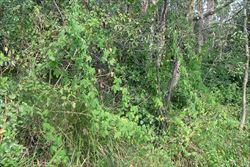
infestation (Photo: Sheldon Navie)
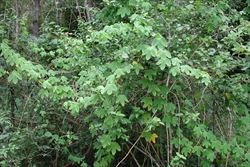
habit (Photo: Sheldon Navie)

bluish-green stem and coiled tendril (Photo: Sheldon Navie)

close-up of the large two-lobed leafy stipule (Photo: Sheldon Navie)
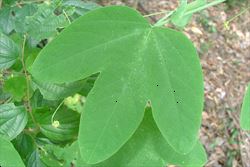
leaf with three rounded lobes (Photo: Sheldon Navie)
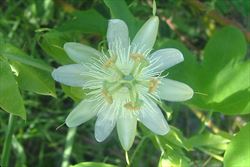
flower (Photo: Sheldon Navie)
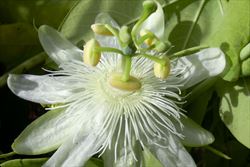
close-up of flower (Photo: Forest and Kim Starr, USGS)
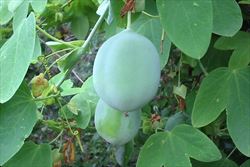
bluish-green immature fruit (Photo: Sheldon Navie)
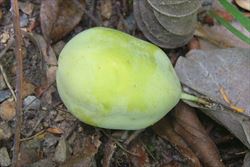
close-up of mature fruit (Photo: Sheldon Navie)

seedling (Photo: Sheldon Navie)
Scientific Name
Passiflora subpeltata Ortega
Synonyms
Passiflora alba Link & Otto
Family
Passifloraceae
Common Names
passion flower, passion fruit, passionflower, white passion flower, white passion-flower, white passionflower, white passionfruit, wild grenadilla
Origin
Native to Mexico, Central America (i.e. Guatemala and Panama) and tropical South America (i.e. Venezuela and Colombia).
Naturalised Distribution
Widely naturalised in the coastal regions of eastern Australia (i.e. throughout eastern Queensland and the coastal districts of eastern New South Wales).
Also naturalised on some Pacific islands (e.g. Hawaii and Tonga).
Habitat
A common weed of roadsides, disturbed sites, waste areas, watercourses (i.e. riparian areas), urban bushland, closed forests, forest margins, open woodlands and plantation crops (e.g. sugarcane) in tropical and sub-tropical regions.
Habit
A vine with climbing or creeping stems, supporting itself with tendrils.
Distinguishing Features
- a vine with slender climbing or creeping stems that are mostly hairless.
- tendrils are produced at the bases of the alternately arranged leaves.
- where the leaf stalk joins to the stems there is a two-lobed leafy structure 1-4 cm long.
- its are pale green with three rounded lobed and whitish or bluish-green undersides.
- its large white flowers (4-5.5 cm across) are borne singly in the leaf forks.
- its leathery egg-shaped fruit (about 4 cm long) are pale green, bluish-green or yellowish when mature.
Stems and Leaves
The stems are slender, hairless or nearly hairless (i.e. glabrous or sub-glabrous) and grow up to 5 m long. Tendrils are produced at the base of the leaf forks.
The alternately arranged leaves are hairless (i.e. glabrous) and borne on stalks (i.e. petioles) 2-6 cm long. Where the leaf stalk joins to the stems there is a two-lobed leafy structure (i.e. stipule) 1-4 cm long, that is somewhat obliquely heart-shaped. The leaf blades (3-10 cm long and 4-11 cm wide) are pale green with whitish or bluish-green undersides. They are three-lobed, with the lobes being cut about half-way into the centre of the leaf blade and having rounded tips (i.e. obtuse apices).
Flowers and Fruit
The white flowers (4-5.5 cm across) are borne singly in the leaf forks (i.e. axils). These flowers have six petals and six sepals, which are all very similar in appearance. They also have five prominent stamens and an ovary topped with three styles and large stigmas. Flowering occurs during spring and summer.
The fruit are pale green to bluish-green or yellowish when mature. These fruit are leathery berries (about 4 cm long) that are egg-shaped (i.e. ovoid) to almost round (i.e. sub-globose) in shape.
Reproduction and Dispersal
This species reproduces by seed, which are commonly spread by birds and other animals that eat the fruit.
Environmental Impact
White passionflower (Passiflora subpeltata) is regarded as an environmental weed in Queensland and New South Wales, and was recently listed as a priority environmental weed in at least one Natural Resource Management region.
Other Impacts
White passion-flower (Passiflora subpeltata) contains cyanic acid and is thought to be poisonous to humans and livestock if eaten in sufficient quantities. Unlike many other passionfruit species, its fruit are not edible.
Legislation
Not declared or considered noxious by any state government authorities.
Management
For information on the management of this species see the following resources:
- the Biosecurity Queensland Fact Sheet on this species, which is available online at http://www.dpi.qld.gov.au.
Similar Species
White passion flower (Passiflora subpeltata) can be distinguished from two other very similar species, corky passion vine (Passiflora suberosa) and stinking passion vine (Passiflora foetida), by its leaves:
- corky passion vine (Passiflora suberosa) has hairless or slightly hairy leaves with three pointed lobes.
- stinking passion vine (Passiflora foetida) has hairy leaves with three pointed lobes.
- white passion flower (Passiflora subpeltata) has hairless leaves with three rounded lobes.

